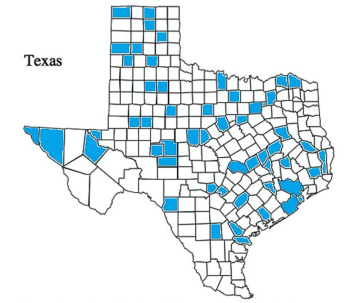We decided early on that our group would do more than simply lament the outcome of the 2016 election. We took a look at the issues we cared about, how they were being handled in Texas, and decided to get started on one: Women’s healthcare.
Our “Healthy Skepticism: The Inadequacy of ‘Healthy Texas Women’ in 2018” finds that the people in charge of the Healthy Texas Women program are lying to Texas women.
“Healthy Skepticism” report highlights
• A statistically representative survey of 54 counties in Texas shows 66.31% of providers listed on the HTW website as HTW providers do not provide care through Healthy Texas Women.
• In Dallas County, 81.9% of providers listed on the HTW website as HTW providers do not provide care through Healthy Texas Women. Of the 1,043 providers in Dallas County, only 505 are unique names.
• In Harris County, 70% of providers listed on the HTW website as HTW providers do not provide care through Healthy Texas Women. Of the 1,679 hits in Harris County, 1,323 were unique names.
• In addition to duplicate names, numbers listed led us to an anesthesiology group, an orthopedic surgeon group, a dermatologist, an oncologist, a radiology department, a mental health specialist, a surgeon, a cancer institute, an ophthalmologist, pediatricians, a city employee clinic, several ER/urgent care doctors, and the private line of someone named Louis. Some were no longer taking new patients. One said they used to take HTW patients but the state is not giving them money any more. Sometimes we stayed on hold for up to 15 minutes and never got through. One person hung up on us when we asked about HTW. Sometimes we tried and never even got to a person to put us on hold. We were persistent.
Background
In an effort to defund Planned Parenthood, the Texas legislature cut the two-year budget for funding family planning in 2011 from $111 million to $38 million and ended state funding to Planned Parenthood in 2011.
The result: 82 Texas family planning clinics — 25% of those in our state — closed or stopped providing family planning services, this Washington Post article reports. “An unintended consequence of the law was that two-thirds of the clinics that closed were not even Planned Parenthood clinics.”
The legislation also “prohibited any doctor or clinic associated with abortion care from participating in the Women’s Health Program, the state’s Medicaid fee-for-service family planning program,” the article explains. “This effectively excluded Planned Parenthood, which until then had cared for more than 40% of the program’s clients. Over the two-year period following the funding cuts and exclusion from the Women’s Health Program, 31 of Planned Parenthood’s 74 Texas family planning clinics closed. (The others were able to stay open through payments from private insurance plans, out-of-pocket payments for other care, grants and donations.)”
The gap left by the lack of Planned Parenthood clinics and services was huge.
In 2014, the state created the Texas Women’s Health Program and the Expanded Primary Health Care for Women program. In 2015, NARAL released a study on the programs and how they were filling that gap. That study found that “some Texas counties do not have any valid providers under the program.”
According to NARAL three years ago today: “We recently conducted an in-depth spot check of all the Texas Women’s Health Program (TWHP) provider listings in 26 Texas counties to check and see if the providers it lists on its website are actually offering full gynecology services. Of the 681 TWHP provider listings, there are only 113 actual providers offering services and taking new TWHP clients. Of these places we called, many did not routinely offer the preventative gynecological services that TWHP is meant to cover because they are emergency rooms, fertility clinics and, in one instance, a Subway Sandwich shop.”
These programs were consolidated and replaced in July of 2016 by the Healthy Texas Women program, which is available for women age 18 to 44 who meet this criteria. At the time, Sen. Jane Nelson (R-Flower Mound) said 5,000 providers had signed up. One year later,Lesley French, an associate commissioner at the Texas Health and Human Services Commission, said the number was up to 5,300 and growing. The program’s website promises to help women “take charge” of their health: “From annual exams and family planning to disease screenings and treatments, we’ve made it easier to find the women’s healthcare services you need.”

Since the NARAL study was done under the previous programs, we wanted to see if the state was living up to its promises. And thus, our “Healthy Skepticism” report was born. Our group sought to determine whether the Healthy Texas Women Program is being implemented properly across the state. To find out, we made phone calls to a representative sample of HTW providers.
Methods
First, a full listing of all 254 counties in Texas were listed, by population size. We then sought advice from Dr. Annie Wright, a local research scientist (who is the daughter of a church friend, because that’s how we roll at EDPW).
To ensure that counties of varying size were represented, a stratified random sampling procedure was used to select 54 (approximately 21%) of all counties, representing small, medium and large counties. We gathered lists of zip codes that make up each county.
 Volunteers visited the Healthy Texas Women’s website. For each zip code within the selected 54 counties, any website “hits” from the website were recorded. A total of 3,945 hits were initially pulled from the website along with the phone number listed on the site. A hit included either an individual medical provider (3,339, 84.64% of those listed) or a clinic with no individual medical provider listed (606, 15.36% of those listed). There were also zip codes that had no hits; of the 54 randomly chosen counties, 17 did not have any hits, meaning there were no providers taking part in the HTW program in those 17 counties.
Volunteers visited the Healthy Texas Women’s website. For each zip code within the selected 54 counties, any website “hits” from the website were recorded. A total of 3,945 hits were initially pulled from the website along with the phone number listed on the site. A hit included either an individual medical provider (3,339, 84.64% of those listed) or a clinic with no individual medical provider listed (606, 15.36% of those listed). There were also zip codes that had no hits; of the 54 randomly chosen counties, 17 did not have any hits, meaning there were no providers taking part in the HTW program in those 17 counties.
The HTW website gives a choice of finding providers within 5, 10, 20, 50 or 100 miles from a user’s zip code. To cut down on hits that are repeats of the same location, the lowest choice, 5 miles, was used, minimizing overlap. In counties where zip codes are less than 5 miles apart, care was taken to not list the same provider at the same location more than once.
NOTE: There are many instances in which a provider is listed on the HTW website more than once within a single zip code at a single telephone number. There are also instances in which a single provider is listed multiple times with multiple phone numbers. Each listing is included in this survey.
To increase feasibility, a second randomization strategy was used. In any counties with less than 1,000 hits, we called all hits (providers or clinics). In counties with greater than 1,000 hits, 10% were randomly selected for calls. This was the case for two counties, Dallas County and Harris County.
Over a period of two months (from mid-January to mid-March, 2018), 12 volunteers called 1,495 providers and recorded the answers to these questions:
- Do you accept patients in the Healthy Texas Women program? If yes, then:
- Could I get a pap smear, breast exam, birth control and STD testing?
- When is your next available appointment?
We created a Google Sheet to keep track of all assigned calls and responses. Under the column “Care available through HTW” on the spreadsheet, surveyors would mark “yes” if the provider accepted HTW patients and could provide any of the four services. They would mark “no” if for some reason, a woman could not get care there, whether because they did not accept HTW, the provider was not at that number, or the provider did not offer these services. Surveyors were encouraged to write reasons in the “other notes” column.
Results
Within the 52 Texas counties with less than 1,000 hits per county, we called 1,223 hits. Of those hits:
- 382 (31.23%) provided care through Healthy Texas Women.
- 811 (66.31%) did not provide care through Healthy Texas Women.
- 30 (2.45%) were repeats.
- 269 zip codes had no hits.
Of the providers that took HTW and could provide appointment times:
- 37.01% could make an appointment within a week.
- 19.69% within two weeks.
- 24.41% within a month.
- 12.20% within two months.
- 6.69% in more than 2 months.
The other two counties have been broken out, as they are large urban areas:
Dallas County
There were 1,043 hits in Dallas County, so we randomly selected 10% of the providers for calls. Of that sampling:
- 10 (9.52%) provided care through Healthy Texas Women.
- 86 (81.9%) did not provide care through Healthy Texas Women.
- 9 (8.57%) were repeats.
- 2 zip codes in Dallas County had no hits.
Of the providers that took HTW and could provide appointment times:
- 70% could make an appointment within a week.
- 10% within two weeks.
- 10% within a month.
- 10% within two months.
Harris County
There were 1,679 hits in Harris County, so we randomly selected 10% of the providers for calls. Of that sampling:
- 50 (29.94%) provided care through Healthy Texas Women.
- 117 (70.06%) did not provide care through Healthy Texas Women.
- 1 zip code in Harris County had no hits.
Of the providers that took HTW and could provide appointment times:
- 42% could make an appointment within a week.
- 22% within two weeks.
- 8% within a month.
- 28% within two months.
Multiple listings
It should be noted that within the two large counties, Dallas and Harris, multiple listings of the same provider with different phone numbers or offices was commonplace, especially in Dallas.
- Of the 1,043 hits in Dallas County, only 505 are unique names.
- Of the 1,679 hits in Harris County, 1,323 were unique names.
Geographic challenges
Even when a doctor takes Healthy Texas Women patients and can perform the services we asked about, there is no guarantee a woman could get to the doctor to receive care. Although we called up numbers within a five-mile radius of a zip code, sometimes the number given is a call center — and the location of the call center has little bearing on the location of the doctor’s office. For instance, in the county of Galveston, there are 55 service providers listed with the same phone number. It is a call center. Of those 55, 28 are beyond the five-mile limit, some as far as 141 miles away and one that is 387 miles away.